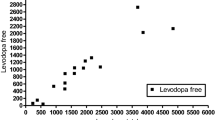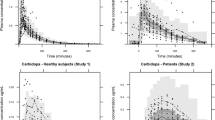Summary
In the present study in vivo microdialysis sampling coupled to high-performance liquid chromatography with electrochemical detection, was used to study the pharmacokinetics of levodopa and 3-O-methyldopa in skeletal muscle in dog, after intravenous administration of levodopa. For comparison, the pharmacokinetic parameters of both compounds were simultaneously determined in plasma using blood collection. Muscle microdialysis samples and blood were continuously collected for 4 h after the administration of levodopa (25 mg/kg). Pharmacokinetic profiles of levodopa in plasma and muscle were different. The mean Tmax value of levodopa in plasma and muscle was 0.16 h and 1.0 h, respectively.
The AUC0→inf for levodopa in plasma was nearly 18-fold higher in plasma than in muscle. The 3-O-methyldopa concentration increased very rapidly after the administration of levodopa, to reach a plateau after 2.5 h and 3 h in plasma and muscle, respectively. The AUC0→4 for 3-O-methyldopa was 3.6-fold higher in plasma than in muscle. The ratio levodopa/3-O-methyldopa, reflecting the metabolic rate of levodopa, was 3.5 times higher in plasma than in muscle, at the peak value of levodopa, and then rapidly declined to values lower than 1, one hour after administration of the drug. We compared our results with literature data from postmortem studies done in rat experiments.
We concluded that levodopa is not accumulating in muscle as such, but is converted to 3-O-methyldopa probably before leaving the plasma compartment.
Similar content being viewed by others
References
Axelrod J, Tomchick R (1958) Enzymatic O-methylation of epinephrine and other catechols. J Biol Chem 233:702–705
Cotler S, Holazo A, Boxenbaum HG, Kaplan SA (1976) Influence of route administration on physiological availability of levodopa in dogs. J Pharm Sci 65:822–827
Daniel PM, Pratt OE, Spargo E (1977) The metabolic homeostatic role of muscle and its function as a store of protein. Lancet 11:446–448
Deleu D, Ebinger G, Michotte Y (1987) Erratic absorption of levodopa in parkinsonian patients with fluctuating motor state. In: Aiache JM, Hirtz J (eds) Proceedings of the Third European Congress of Biopharmaceutics and Pharmacokinetics (III). Imprimerie de l'Universite, Clermont-Ferrand, pp 471–477
Deleu D, Ebinger G, Michotte Y (1991a) A clinical and pharmacokinetic comparison of oral and duodenal delivery of levodopa/carbidopa in patients with Parkinson's disease with fluctuating responses to levodopa. Eur J Clin Pharmacol (in press)
Deleu D, Sarre S, Herregodts P, Ebinger G, Michotte Y (1991b) Continuous intravenous monitoring of levodopa and 3-O-methyldopa by microdialysis and high performance liquid chromatography with electrochemical detection. J Pharm Biomed Anal 9:159–165
Leenders KL, Poewe WH, Palmer AJ, Brenton DP, Frackowiak RSJ (1986) Inhibition of Ir[18F] Fluorodopa uptake into human brain by amino acids demonstrated by positron emission tomography. Ann Neurol 20:258–262
Marsden CD, Parkes JD (1976) “On-off” effects in patients with Parkinson's disease on chronic levodopa therapy. Lancet 1:292–296
Michotte Y, Moors M, Deleu D, Herregodts P, Ebinger G (1987) Simultaneous determination of levodopa, carbidopa, 3-O-methyldopa and dopamine in plasma using high-performance liquid chromatography with electrochemical detection. J Pharm Biomed Anal 5:659–664
Nutt JG, Fellman JH (1984) Pharmacokinetics of levodopa. Clin Neuropharmacol 7:35–49
Ordonez LA, Romero JA, Wurtman RJ (1972) Tissue distribution of l-dopa: evidence for a reservoir in skeletal muscle. Fed Proc 31:5–89
Rose S, Jenner P, Marsden CD (1988) The effect of carbidopa on plasma and muscle levels of l-dopa, dopamine, and their metabolites following l-dopa administration to rats. Movement Disorders 3:117–125
Sasahara K, Nitanai T, Habara T, Morioka T, Nakajima E (1980) Dosage form design for improvement of bioavailibility of levodopa II: Bioavailibility of marketed levodopa preparations in dogs and parkinsonian patients. J Pharm Sci 69:261–265
Spargo E, Pratt OE, Daniel PM (1979) Metabolic functions of skeletal muscles of man, mammals, birds and fishes: a review. J Royal Soc Med 32:921–925
Wade LA, Katzman R (1975) 3-O-methyldopa uptake and inhibition of l-dopa transport at the blood-brain barrier. Life Sci 17:131–136
Yahr MD (1977) Long-term levodopa in Parkinson's disease. Lancet 1:706–770
Author information
Authors and Affiliations
Additional information
Send offprint requests to D. Deleu at the above address
Rights and permissions
About this article
Cite this article
Deleu, D., Sarre, S., Ebinger, G. et al. In vivo pharmacokinetics of levodopa and 3-O-methyldopa in muscle. Naunyn-Schmiedeberg's Arch Pharmacol 344, 514–519 (1991). https://doi.org/10.1007/BF00170645
Received:
Accepted:
Issue Date:
DOI: https://doi.org/10.1007/BF00170645




